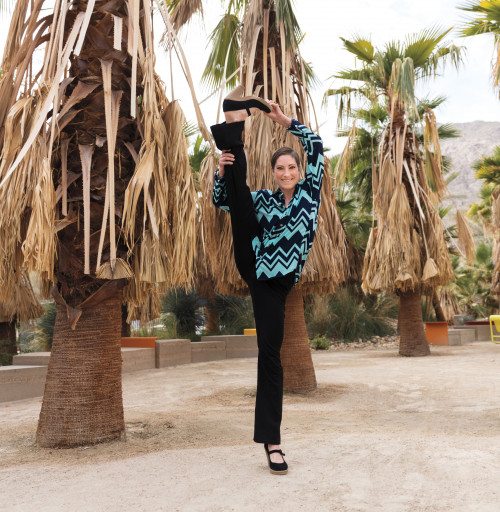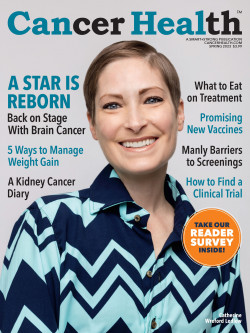It was the final pit stop on last year’s season 8 of The Amazing Race Canada. As they jogged into Vancouver’s gargantuan BC Place stadium, race partners Catherine Wreford Ledlow, 42, and Craig Ramsay, 45, realized they were the first to arrive. “Oh, my gosh…oh, my God…we did it!” Ramsay cried out.

Catherine Wreford Ledlow with Craig Ramsay on “The Amazing Race Canada”Courtesy of Catherine Wreford Ledlow
Holding hands, they rushed to the platform, a tiny island in a sea of artificial turf, where the eliminated contestants and the show’s host, Jon Montgomery, were waiting to greet them. Amid clapping and cheering, Wreford Ledlow and Ramsay caught their breath and hugged. “Is this…is this for real?” she asked, looking stunned.
Her shock was understandable. The Canadian duo—dubbed Team Broadway for their roles in hit shows such as Fiddler on the Roof and Chitty Chitty Bang Bang (Ramsay) and Oklahoma! and 42nd Street (Wreford Ledlow)—had just completed The Amazing Race Canada, which had been delayed for nearly three years due to the COVID-19 pandemic. During the odyssey, they had covered over 12,400 miles, crisscrossed five provinces and visited 24 cities. Their win also celebrated another significant achievement: Wreford Ledlow’s pluck and tenacity in working around the challenges of terminal brain cancer.
Rewind to 2013
Back in 2013, Wreford Ledlow was following a different life plan. She had been a musical theater star until injuries led her to hang up her dance shoes. Based in Los Angeles, she ran a mortgage company for three years and later waitressed nights at a high-end sushi restaurant so she could take prerequisites for a nursing degree by day. While in LA she met and married her husband, Joel Ledlow, 49, a martial arts instructor, and they had a son, Elliot, now 12. They subsequently moved to Oklahoma City, where Wreford Ledlow finished her nursing degree and gave birth to their daughter, Quinn, now 9.

Catherine Wreford Ledlow with husband Joel and kids Elliot and QuinnCourtesy of Catherine Wreford Ledlow
In June, five weeks after Quinn’s birth, Ramsay visited Wreford Ledlow to celebrate her 33rd birthday. The two first met at the Royal Winnipeg Ballet School when she was 16 and he was 19, and they’ve been friends since.
During Ramsay’s visit, they were making a video of Wreford Ledlow doing dips and lifting Quinn in her BabyBjörn carrier. “I said, ‘Craig, we have to stop, my head just hurts too much,’” she recalls.
Ramsay knew something was seriously wrong; his best friend would never stop a workout unless she was in excruciating pain. He made her promise to see a doctor. A bout of dizziness that Sunday night and a call to her midwife the next morning reinforced the urgency to seek medical care.
She headed for the hospital where she had finished her nursing training and had two EKGs to rule out a heart-related problem. Next, she got a CT scan to see whether her natural birth with Quinn had caused a small brain bleed.
When Wreford Ledlow emerged from the scanner, everyone’s faces were white with shock.
“All these doctors started coming into the room, and they said, ‘You have a mass on your brain, and we need to take it out immediately,’” Wreford Ledlow says. Knowing that she was a nurse, they asked whether she wanted to see the scan. The tumor, on the left side of her head, was bigger than her fist. “My brain was all pushed over to one side.”
The doctors sent her to get an MRI to determine the parameters of the mass.
“I just remember lying there, not moving, with tears going down my face, not knowing what to do and just thinking, This is going to change my life forever,” Wreford Ledlow recalls. “And it did.”
Treatment and the Road to Healing
The mass in Wreford Ledlow’s brain was an astrocytoma, the most common type of brain tumor—specifically, an anaplastic type, which tends to be fast-growing. Surgery to remove the tumor was scheduled for early July. The hours-long operation had to be performed while she was awake to avoid damaging her brain’s speech center, which the tumor impinged upon. Still, she was unable to speak right after the operation and had almost daily speech therapy for about six months.
“A week after surgery, I would talk like this: ‘I (long pause) want (long pause) to (long pause)….’ And I couldn’t write anything. I could see what I wanted to write, but I was writing jibber jabber,” Wreford Ledlow says.
Six weeks post-op, she underwent six weeks of chemotherapy and radiation at a center close to her home in Oklahoma City—which was fortunate because the risk of seizures meant she couldn’t drive. Over the next year, after a six-week hiatus, she was given six rounds of four different kinds of chemotherapy—two oral, two intravenous—which turned her blond hair chestnut brown. She had the last chemo doses in Winnipeg, where she and Joel relocated their family to be near the Wreford clan.
Wreford Ledlow has been on an anti-seizure medication since shortly after her surgery and hasn’t had a seizure in about five years. She goes in for MRIs every three months because the tumor will come back, inevitably, as either another astrocytoma or a glioblastoma.
Given that reality, she asked herself what she wanted to do with the time she had left. “I was like, What can I do that makes me fulfilled? And I thought, I want to perform.”
Confronting the Hurdles
Memorizing lines and dance steps is an essential part of a performer’s job. Post-surgery, Wreford Ledlow’s short-term memory loss made returning to the stage more difficult. “I started trying to learn lines, and I couldn’t do it,” she says. Undeterred, she found another way: “I started learning my lines and singing my songs three times a day.”

Catherine Wreford Ledlow as Chicago’s RoxieCourtesy of Catherine Wreford Ledlow
It’s a practice she continues to this day. And it works because she receives the material way in advance—she is open about her cancer and limitations. During a show, when she goes offstage, she asks what comes next, and stagehands will tell her, “This is where you come on; this is what you do,” she says. “Or I have it written on the side of the stage.” In 2019, in the musical Fun Home at the Royal Manitoba Theater Center, she was even able to play the lead character, Alison, who is an artist, without ever leaving the stage by having the first of her lines for every scene written on a sketchpad.
But on The Amazing Race, nothing was provided in advance. One tap dance number required her to learn four sets of steps. “I could do the steps, but I couldn’t remember the order,” she says. “I think I did it all 10 times. But I got it.” She also jotted clues and details of each day in a notebook, which she credits with helping Ramsay and her win.
Giving and Getting Help
One day Wreford Ledlow was speaking with another woman in the waiting room of her oncologist’s office. Their similarities were uncanny. The woman, Carrie, had two kids and was a year older than Wreford Ledlow. And she had an anaplastic astrocytoma. When Wreford Ledlow learned later that day that she had the same type of tumor, she immediately phoned Carrie, and they talked for hours. The conversation helped Wreford Ledlow come to terms with her diagnosis, and the experience convinced her to become an advocate.
That led her to the Brain Cancer Foundation of Canada. “I’ll volunteer for anything they ask me to do.” She has given away the football at a Winnipeg Blue Bombers game and sung the national anthem with her kids at a Jets hockey game, and she runs a monthly support group for people throughout the province of Manitoba. Before the coronavirus pandemic, meetings were held in person, but they’re now online, “which is good and bad,” Wreford Ledlow says. On the one hand, getting to in-person gatherings is hard because many who have brain cancer can’t drive. On the other hand, “they forget a lot of things or can’t figure out how to get onto a computer. So we deal with a lot of things like that.”

Catherine Wreford LedlowKevin McDermott
Wreford Ledlow is driven by the reality that brain cancer has no cure. “I don’t even get to say, ‘Five years? Yep, I’m in remission.’ You can’t ever be in remission.” She’d like to see this disease transformed from a death sentence into a lifelong illness, like diabetes. To spread awareness and raise money, she has embarked on motivational speaking, sharing her cancer journey.
Wreford Ledlow was given two to six years to live when she received her diagnosis. Initially, she thought she would never accept that her cancer was terminal, but her outlook has changed “100%,” she says. “I’m happier now because little things don’t bother me anymore. I don’t really have to do anything. I mean, I have to earn a living, but I do what I love.” She is now approaching her 10th year post-diagnosis. “I always say I’m past my expiration date,” she says, with a characteristic laugh.
Besties Offer Advice:
What You Can Do for a Loved One With Cancer
Research has shown that people with cancer who receive emotional support from friends and family are better able to adjust to the changes wrought by their disease and feel more positive. Their quality of life is often better too. Catherine Wreford Ledlow considers herself “super lucky” to have the loving help and support of many, including her mother, but none more so than Craig Ramsay, her longtime gay friend, Amazing Race partner and soulmate.
“Craig and I have such a close connection—we know what each other is feeling,” Wreford Ledlow says. “We’re never competing. We just have this way of rooting for each other from the bottom of our hearts. I feel like everyone needs a Craig in their life.”
“As her best friend, I’m there to remind her of how incredible she is,” Ramsay says. “A champion and warrior with every single task that’s in front of her.” During The Amazing Race, they experienced the gamut of feelings together. “Behind closed doors, when we finished one of the pit stops, our emotions would go from being overjoyed to tears of both joy and sadness because we didn’t want it to end.” They also had deep conversations on topics like her wishes for her children’s future. And he felt fortunate to witness her moving beyond some of the limitations imposed by her terminal illness—to function better, improve her vocabulary and communication skills and boost her memory. Now a fitness and wellness author, Ramsay says, “It’s the lesson that we shouldn’t shy away from challenges. We should tackle them to the best of our abilities.”

Spring 2023 issue of Cancer Health







Comments
Comments